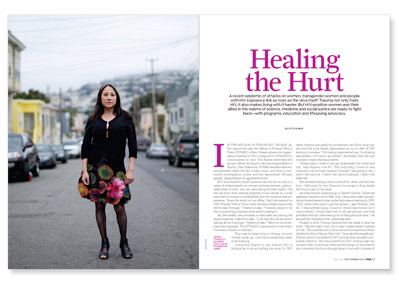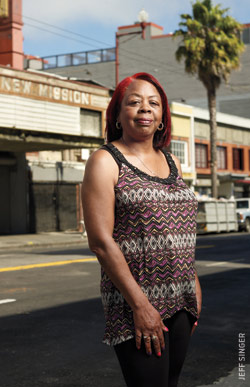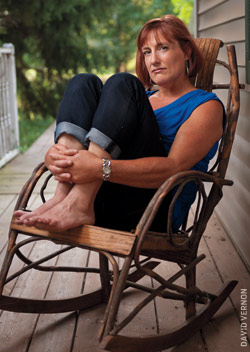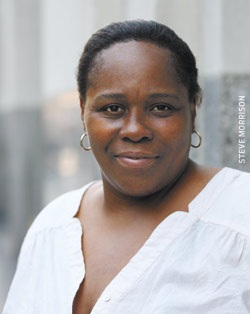
In the middle of the night on May 24, fire ripped through the offices of Women With a Vision (WWAV), a New Orleans grassroots organization founded in 1991 to respond to HIV/AIDS in communities of color. The flames destroyed the group’s offices, forcing it to relocate temporarily to a church. Deon Haywood, WWAV executive director, immediately called the fire a hate crime, and after a two-month investigation, police and fire department officials agreed, categorizing it as aggravated arson.
HIV and women’s health activists see the fire as one in a series of violent attacks on women and transwomen, particularly those of color, who are advocating for their rights. The fire did more than destroy property; it also served as a cruel reminder of women’s vulnerability and the violence they experience. “Since the attack on our office, I feel that many of us with Women With a Vision have revisited every trauma that we’ve been through,” Haywood says. “Violence seems to be this normal thing, because we’re used to seeing it.”
Yet, few health care providers or advocates are putting the pieces together, Haywood says. “I just feel like people aren’t talking about it enough,” Haywood says. “Most of our movements are separate. The HIV/AIDS community is over there. Domestic violence is over here.”
That may be beginning to change, as more women speak up—and some researchers seem to be listening.
 |
| Cassandra Steptoe |
“Many nights I used to just get underneath the covers and cry,” says Steptoe, now 56. “The only thing I could do was continue to shoot dope, because I thought I was going to die. I didn’t tell my kids. I didn’t tell my ex-husband. I didn’t tell anybody.”
She avoided seeing a doctor until 2001, when she fled San Jose, California, for San Francisco to escape a drug dealer who’d put a gun to her head.
Another woman speaking up is Valerie Holmes. Drawn by payments handed out by New York City public health groups, she got tested several times under fake names starting in 1999. “But I never went back to get my results,” says Holmes, now 46. “I was actively using. I knew if I would have found out [I was positive] I would have had to tell my partner, and that probably wouldn’t have been good at that particular time.” He abused her, verbally at first, physically later.
Finally, in 2006, Holmes decided she was ready to face the truth. “My life wasn’t bad, but it wasn’t really where I needed it to be.” She marched into a clinic across the street from where she lived in Mount Vernon, New York. “I just asked for everything.” Holmes asked to be tested for HIV and any other sexually transmitted infection. She was positive for HIV. Holmes says she smoked crack cocaine but never injected drugs, so she believes she contracted the virus through years of sex with a variety of men. Her partner, who was HIV negative, accused her of cheating on him.
Holmes and Steptoe live on opposite coasts, but they’ve traveled similar paths. Both were molested as children and abused by men as adults. Holmes put off learning her HIV status, while Steptoe kept hers secret for years. Their stories illustrate the interconnectedness of violence and HIV in women, a relationship that researchers are beginning to recognize can affect their health for years.
Scientists have long known that sexually and physically abused women have a greater risk of contracting HIV. Now, a growing body of research shows that once they are positive, traumatized women don’t do as well in treatment and are more likely to engage in risky behaviors. “It appears that trauma, especially in women, is a key driver of every aspect of the epidemic,” says Edward Machtinger, MD, Steptoe’s doctor and director of the Women’s HIV Program at the University of California at San Francisco.
The estimated rate of intimate partner violence among all U.S. women is about 25 percent, shocking in itself. Among HIV-positive women, though, the estimated rate is more than twice that, according to Machtinger.
“How can you have safe sex in an unsafe relationship?” asks Anna Forbes, who has long worked in HIV prevention. “If asking him to put on a condom gets you a fist in the face, it’s not going to work.”
Despite the growing awareness, fewer than 10 percent of all providers of HIV services routinely screen for intimate partner violence, according to a 2009 report from the federal Health Resources and Services Administration.
“I think one of the reasons providers don’t ask about abuse is they don’t feel comfortable or confident about how to treat a patient who’s been abused,” Forbes says. “You have to assume that [abuse] is part of the constellation [of issues in a person’s life] until it’s ruled out.”
Providers’ ignorance about how best to care for and treat HIV-positive women isn’t surprising, Forbes says. “HIV started out in the U.S. as a men’s disease,” she says. “The AIDS world is still working off that paradigm and still isn’t adapted to working with women.”
But women represent a growing proportion of the HIV/AIDS epidemic in the United States. Today, they account for at least 27 percent of all new diagnoses, up from 8 percent in 1985 and 14 percent in 1992, according to Machtinger. And, he says, more than three-quarters of women who are newly diagnosed with HIV are black, like Steptoe and Holmes, or Latina. Studies show that black women, both positive and negative, also experience disproportionately high levels of violence.
“Why is there less funding right now for people with HIV? Why is there less press about the epidemic?” Machtinger asks, then offers an answer. “I would have to say [it’s because] the people being infected right now are much more disempowered.”
Machtinger’s institution recognized early on that its AIDS clinic wasn’t meeting women’s needs. “The AIDS clinic was pretty much designed for men,” he says. “The women who were coming in were very different. For the most part, we were seeing poor women, women who were under-educated.”
 |
| Kat Griffith |
Even today, the stigma of HIV weighs more heavily on women than on men, Forbes says. “With women, it’s still much more ‘you must be a whore or a tramp,’” she says.
Besides, women have too much other stuff to worry about than their own health. “It’s almost part of the culture of being female,” says WWAV’s Haywood. “You automatically never think about yourself. There’s always somebody else we’re caring for.” A violent partner can wield a woman’s HIV status like a weapon by threatening to take her children away if she speaks out about being beaten, Haywood adds.
Certainly, not all victims of intimate partner violence are women. But “women have a more submissive role in this world,” says Gail Wyatt, PhD, a UCLA psychologist who has pioneered research into the relationship between violence and HIV in women. HIV positive or not, she says, “we usually have more dependence on a partner for our survival.”
Something as simple as the need for their partner’s health insurance traps some HIV-positive women in abusive relationships, says Kat Griffith, a 42-year-old Metamora, Illinois, woman who contracted HIV from her college boyfriend and was diagnosed 20 years ago.
“A lot of times, men will use their medications against them, like holding them for ransom,” says Griffith, who helped the National Network to End Domestic Violence develop a curriculum to teach health care providers about the intersection of violence and HIV/AIDS.
Griffith’s parents divorced when she was 5, and she says, her mother was either drunk or working throughout most of Griffith’s childhood. While the man who infected her was not violent, Griffith says, her high school boyfriend was. “There is no question in my mind that the traits that led me to the violent relationship are some of the same traits that kept me from protecting myself,” she says. “I could have easily contracted the virus as a teenager, when I had such low self-worth that I would do whatever drugs someone wanted me to do. I was not taking care of myself. I was a bit self-destructive.”
Her college boyfriend mistakenly thought he’d been tested for HIV when he underwent surgery before he met her, Griffith says. Although “he [slept around] before he met me” and didn’t pressure her to have unprotected sex, they eventually stopped using condoms, a move Griffith thought significant enough to note in her journal.
They learned he was HIV positive in 1992 when he was diagnosed with AIDS. Griffith tested positive a few weeks after that; her boyfriend died in 1994.
UCSF established the Women’s HIV Program in 1994. Machtinger came on board in 2000 and became director in 2004. People in the program can talk about housing issues with their social worker, child-rearing with the family case manager, medications with a pharmacist and preventive health with their gynecologist—all in one morning. Despite the comprehensive care provided by the program, though, Machtinger noticed that a fifth to a quarter of the patients were faring poorly. “We realized there was something missing in our model,” he says. “It was very frustrating.”
That doesn’t surprise UCLA psychologist Wyatt. “These are people who usually don’t want to go to the doctor,” she says. “They’re very suspicious of people touching them and asking them questions about their histories.” Even when it’s performed by a doctor, a pelvic or breast exam might trigger post-traumatic stress disorder, she says, adding that “a lot of women say taking [their daily HIV] medicine reminds them that they are positive,” stirring up unwanted memories of how they contracted HIV.
To identify factors linked to why people fail to stay on HIV treatment and why they engage in risky behaviors that could spread the virus (and expose positive people to additional infections), Machtinger and colleagues at UCSF and Massachusetts General Hospital analyzed data from 113 HIV-positive and transgender and non-transgender women. In an interview with a trained female counselor, each woman answered 97 questions about an array of characteristics and behaviors that could be associated with their health and whether they were likely to engage in behaviors that could infect others. “What we came up with was a big surprise to us,” Machtinger says. Being threatened or abused or subjected to violence within the past 30 days was the single biggest factor linked to both risky behaviors that could spread HIV and to the failure of antiretroviral therapy. “A light went on for me and our program,” he says. “It wasn’t just any trauma that resulted in these outcomes, it was recent trauma. Recent trauma is something that we might be able to do something about.”
Toward that goal, Machtinger’s program conducted a pilot study of a program called Seeking Safety, a cognitive-behavioral therapy developed by a Harvard psychiatrist to treat people with post-traumatic stress disorder (PTSD) who are also addicted to drugs and alcohol. The UCSF researchers adapted Seeking Safety to treat HIV-positive transgender women, who have disproportionately high rates of PTSD as well as substance abuse. Machtinger and his colleagues selected 12 of the 25 Seeking Safety modules that they thought would work best for their patients.
Seven women enrolled in the study, and they were asked to attend 12 weekly sessions, one for each module, conducted by two social workers. The modules covered such topics as “PTSD: Taking Back Your Power,” “Healthy Relationships” and “Taking Good Care of Yourself.” Six of the seven women completed at least seven sessions, and at the end of the study, participants’ PTSD, sense of HIV stigma, and drug and alcohol use had declined overall. While the pilot study found Seeking Safety showed promise, the researchers say larger studies are needed to fully explore its potential in HIV-positive women, both transgender and non-transgender.
Even if an HIV-positive transgender woman is open about her status and willing to seek care, she’s unlikely to find it—even more so than a non-transgender woman, says JoAnne Keatley, a transgender woman who directs the Center of Excellence for Transgender Health at UCSF. “If you were a transperson living with HIV in most places in this country, it would be very difficult to find a physician who has the requisite skills to care for your medical needs,” Keatley says. “They need help kind of wrapping their brains around dealing with issues of different-bodied people.”
When transgender women are victims of trauma, law enforcement officials often side with the perpetrators who defend themselves by saying, “Oh, you know, this is a dude that fooled me,” Keatley says.
Cecilia Chung, a trans woman who now serves as a health commissioner in San Francisco, says she contracted HIV when raped by another jail inmate. Chung had always known she wanted to transition to becoming a woman. Born in Hong Kong, Chung moved with her family to San Francisco in 1984. After graduating college in 1991, Chung, now 47, began the process. “I decided that was something I could not hide from myself anymore.”
Neither her family nor her employer accepted the changes in Chung. “I had a fallout with my family because they did not know how to deal with my decision to transition,” she says. “Also, because there were no legal protections for transgender people, I quickly lost my job.” She had been a court interpreter. “I think some of the judges became uncomfortable.” Chung was on the verge of becoming homeless. “It was pretty overwhelming in a short period of time,” she recalls. “The change for me from being male to coming to my womanhood was a very painful journey.”
She turned to crystal meth, because her fear of needles prevented her from using injection drugs. She lived in cheap hotels in bad neighborhoods. Sometimes she slept in her car, when she still had a car. To survive, Chung depended on what she calls “the street economy,” which is what led to her arrest.
Still, Chung feels lucky. She learned she was HIV positive not long before the first HIV drugs became available. And she lives in San Francisco, whose city health department for years has run Transgender Tuesday, a clinic that provides care for transgender individuals.
 |
| Valerie Holmes |
About three years ago, Holmes went through a program called Healing Our Women, developed by UCLA psychologist Wyatt for HIV-positive women who’ve experienced trauma. Healing Our Women is made up of 11 weekly two-hour sessions led by specially trained facilitators as well as peer mentors—other HIV-positive women who’ve been through the program. Participating in the group enabled her to open up about her past, Holmes says. “In order for me to get better, I needed to let it go and try to forgive the people who had done what they did to me.” She learned how to build skills and solve problems. “It was about me dealing with me, so I could get to know how to deal with my partner or partners.”
After completing the sessions, Holmes facilitated Healing Our Women groups through Project Street Beat, which is Planned Parenthood of New York City’s HIV prevention and care program for women, men and teens who live on the streets. Through the project, she also visited clients in their homes and escorted them to the doctor. “I made sure that they have what they need.”
Steptoe, who had hidden her HIV status for so many years, has now told her story to thousands through performances with a group of HIV-positive women directed by performance artist Rhodessa Jones. “Dr. Eddy,” as Steptoe calls Machtinger, came up with the idea of a collaboration between UCSF’s Women’s HIV Program and the San Francisco–based Jones. Jones is founder and director of the Medea Project, which her website describes as a theater workshop “designed to achieve personal and social transformation with incarcerated women.”
“I have a hypothesis that nondisclosure, not being out, puts women at risk for further victimization,” Machtinger says. “There’s so little visibility of HIV-positive women out there. Now we have these women who have come out publicly.”
Machtinger introduced Steptoe to Jones several years ago. “I didn’t know anything about performing,” says Steptoe, who can now be seen on YouTube.
The more she tells her story, Steptoe says, the more empowered she feels. In the past, she says, she’d “ride [relationships] until the wheels fall off.” Support from Jones and her fellow performers gave her the courage to leave her second husband, an HIV-negative man she’d met at Narcotics Anonymous. He had started to use drugs again and beat her. The jubilation in her voice was clear when she said their divorce was final in June. “I don’t have to live with shame. I don’t have to live with stigma,” Steptoe says. “Having HIV is not a crime. It’s a health condition.”
Returning to Health
If you are living with HIV and violence, there are many ways you can get help. For example, Deon Haywood, executive director of Women With a Vision, says story circles, a form of consciousness-raising or group therapy, encourage women to relate their experiences and hear from others in similar circumstances. “Story circles,” Haywood says, “center the voices of people who are often made invisible in our society. They engender a sense of community and promote healing and collective action.”
Here are a few resources to start with. For more in your area, search the directory at poz.com.
Resources mentioned in this story:
Women With a Vision
wwav-no.org
504.301.0428
Healing Our Women
Project Street Beat
plannedparenthood.org/nyc/15223.htm
ppnyc.org
212.965.4850
Center of Excellence for Transgender Health
University of California at San Francisco
transhealth.ucsf.edu
415.597.8198
Other national resources:
National Domestic Violence Hotline
thehotline.org
800.799.7233
National Center for Transgender Equality
transequality.org
202.903.0112
The Well Project
thewellproject.org
888.616.9355
Positive Women Forum
forums.poz.com






4 Comments
4 Comments